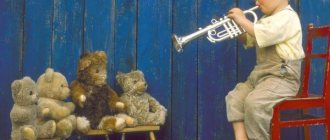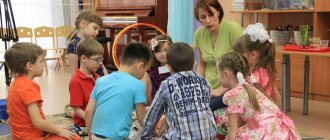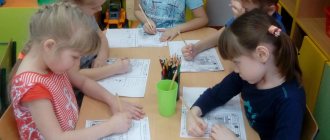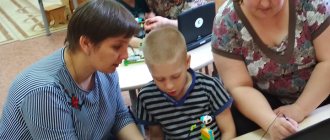The way in which the labor education of preschool children is organized is of great importance. Success in the coming adult life, future practical skills, a responsible attitude to work, a conscious approach to choosing a profession are formed through the joint activities of preschool children and mentors.
Labor education in preschool educational institutions is a means by which:
- basic positive personal qualities and the child’s psychological readiness for adult work are formed;
- pupils develop mental and physical abilities;
- During the lessons, positive, friendly relationships are formed, children get used to working collectively, and learn to appreciate the work of their elders and peers.
Features of the work of a preschooler: how, why and why?
In preschool education, one of the main things is the organization and training in work activity and teaching many of its methods available to children in groups of this age. There has long been an expression among people that labor turned an ordinary animal (monkey) into a highly developed intelligent being (human). And, no matter how exaggerated these words sound, there is some truth in them.
In the process of organizing labor activity, organized and expedient, the child receives the necessary knowledge and skills, but this is not even the main benefit. Through the necessary actions performed by the body, the brain also develops, or rather, even the basic mental functions: thinking, perception, will. That is why labor education of preschool children is a very important and serious area.
The main areas of work activity of preschoolers
For a kindergarten teacher, task number one is to help children get acquainted with the world of adults. Children must learn to perform simple actions themselves: wash their hands and face, sweep the floor, do laundry. Parents do not always realize that the basis of all their child’s skills are labor skills that form independence, determination, and diligence. These qualities will then help the child quickly and easily find his place in society.
The main goal of labor education of children in kindergarten, according to the Federal State Educational Standard, is to develop in them a positive attitude towards work. This can be achieved only by taking into account the age characteristics of the pupils. The type and complexity of the activity in which they are planned to be involved depends on the age of the children.
What goals does the teacher pursue in teaching preschoolers:
- awaken in children a desire to help adults, instill in them a positive attitude towards work;
- desire to deepen and improve work skills;
- achieve a strong habit of employment, responsibility, careful attitude towards one’s own and other people’s products of labor;
- lay the foundations of the ability to organize your work;
- teach children a friendly attitude towards the activities of others, the ability, if necessary, to make tactful comments, and evaluate the results of their activities and the work of a friend.
In accordance with the Federal State Educational Standard, labor activities of preschoolers occur in the following areas:
- mastering self-care skills, which is important for any age group;
- skills in everyday life and housekeeping, work in nature are also characteristic of both the younger group and the preparatory group;
- manual labor is present in the senior and preparatory groups.
?
Work on developing labor skills should be closely related to creativity. To discover the talents of a creative person, seeing joy in work is a necessary condition.
At what age does work begin?
So, since this article is focused exclusively on the preschool age, it is important to define it right away. The final stage is quite obvious: this is the period from 6.5 to 7 years, when the child goes to school. Conventionally, in psychology, the upper limit is considered to be 7 years, but for some the transition to school time (junior schoolchildren) occurs a little earlier, for others a little later. It all depends on a purely formal moment: entering first grade and starting school.
It is much more difficult to determine the lower limit. When can a child’s activity be called work, and can we begin to teach him to perform conscious actions without fear that he will harm himself? In psychology, it is believed that this age begins at 3 years old. Here, too, it should be understood that this is only formal: it is different for different children.
Some are already ready at 2.5, while others are just starting to succeed at 3.5. And yet, at about 3 years old, the child moves from object-manipulative activities (when he touched and felt objects, not always understanding their real purpose) to role-playing games. He develops a social interest and begins to learn how to build relationships and connections. Then it is advisable to begin full-fledged labor education, and the forms can be completely different.
Labor education in relation to different age groups
Preschool age is the best time to develop basic self-care skills, certain skills, and observation. With each stage, the load becomes more complex and requires appropriate actions from the guys. Adults need to remember about age-related characteristics, show patience and kindness, so as not to cause denial in the child.
- The child's fingers are not yet sufficiently developed and do not obey him well.
- The sequence of actions is also not given to the baby; it is difficult to remember everything the first time.
- A younger preschooler will not be able to attract volitional efforts to help; these abilities are still just being formed.
Teachers usually know which teaching methods are appropriate for each age group. They have the responsibility to give recommendations to parents so that children develop harmoniously.
Taking into account the physiological and psychological characteristics of pupils, you need to remember that for children 3-4 years old, the optimal duration of work is 10-15 minutes . Children aged 6-7 years do physical exercise for a maximum of half an hour. The condition of each baby must be monitored. Pay attention to sweating and redness of the skin, when they appear it is better to change your occupation. To prevent children from getting tired, it is better to move on to other activities after 10-15 minutes. When dosing them, be sure to take into account the volume of physical activity and its complexity.
Drawings on the topic of traffic rules in kindergartens - safety through the eyes of children
Labor education in the younger group
Children 3-4 years old are active, often talking about their desire to participate in one activity or another. But they get tired quickly, it is difficult for them to concentrate, so you should not overload them. The assignments of adults in the younger group are more individual in nature; the student will only need to hang up towels or arrange the cutlery for dinner.
Points to consider:
- labor education is situational in nature, for a three-year-old the main thing is that the tasks are simple and understandable;
- children should be praised for any success;
- In order for the child to understand the meaning of his actions, the teacher needs to explain the tasks and evaluate the results;
- Before doing anything, the child needs to observe how an adult copes with it; then the child’s actions follow with step-by-step comments from the teacher.
The main method of working on labor education with children 3-4 years old is personal example. The guys watch the actions of their elders, manual labor, various exercises are carried out in a playful way. Knowledge is consolidated through the example of such famous works as “Fedorino’s grief” or “Moidodyr”.
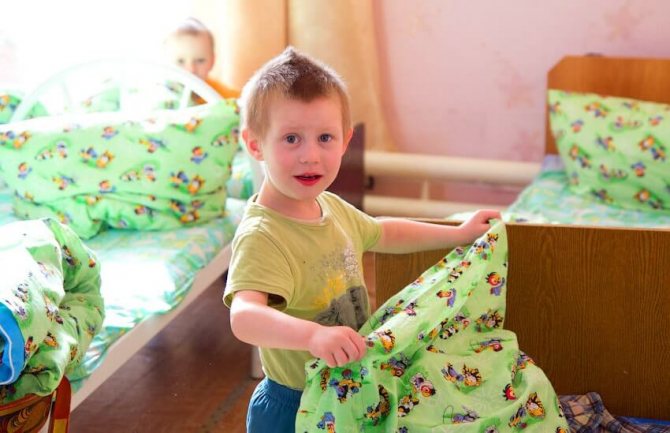
Labor education in the middle group
By the age of four, the baby will be able to handle sweeping paths or washing doll clothes. The tasks gradually become more complex, and the children already have some self-organization skills. They can be entrusted with duty in the dining room or preparing for classes; the children are quite capable of performing simple care for animals in a corner of nature.
In the working method it is important:
- note the child’s desire to help;
- the work is carried out in a playful way (application and design, rules of behavior in various situations are reinforced through role-playing games);
- visual aids are used;
- Conversations are held about the content of future actions and relationships.
Labor education in the senior group
Collective assignments are already being used with children aged 5-7 years. When interacting with each other, children learn to coordinate efforts, agree on something, and share responsibilities among themselves. Playing for children is still the main activity, but they meet the teacher halfway, help replace bed linen in the bedroom or collect leaves on the site.
It is important for the teacher to organize the workspace and equipment. Shovels and watering cans should be bright and comfortable to make children want to play with them. Elegant aprons will create a feeling of celebration. The duration of classes should not be overtiring.
?
The main goal of the labor development process in preschool educational institutions is to develop a respectful attitude towards the activities of adults, familiarity with the main professions, understanding of their significance, and the desire to help.
Labor education in the preparatory group
For older preschoolers, work takes on a systematic nature and becomes more numerous. Children repair books or boxes and sew buttons on their own. Under the supervision of the teacher, they prepare the necessary manuals for classes, counting material, and cut out specified elements from plastic bottles. The guys themselves notice the disorder in the area, water the flowers, and remove fallen leaves.
Solving traffic rules puzzles for preschool children, crossword puzzles
In the seventh year of life, pupils help set the table for dinner, the attendants monitor the availability of soap and towels, the quality of hand washing, and look after the living area.
How does the work of young children differ from adult work?
So, we have resolved the issue of age; now it is necessary to consider what exactly can and should be considered the work of a child. Naturally, it has significant differences with similar activities of an adult. And the main thing is that child labor is largely a voluntary activity, has entertaining forms and is not too extended over time.
Moreover, it has virtually no social significance. That is, everything done by a child and presented as the result of his labor is valuable exclusively for him alone and his peers. True, parents and other relatives can also admire and praise. This is the main feature of the work activity of preschoolers.
We can also add to them that in order to achieve the goal, work must be organized and controlled by adults, clearly explained and shown by example. Children are quite small, and they will not yet be able to achieve the desired result themselves.
Therefore, everything is done only with the guidance of mentors, with clear organization, and has content that is relevant to the child. In other words, he understands and is interested.
What exactly can be considered a child’s work?
And yet, what exactly should be understood by the concept we are describing? Labor refers to any purposeful human activity, conscious and meaningful. It is necessary in order to modify or adapt surrounding objects and thereby satisfy needs.
Simply put, we work to make our own lives easier and create something new and necessary. This, by the way, also includes artistic work, because as a result, a certain material work is created, aimed at satisfying the primordial human need for the beauty of the objective world around it.
Absolutely any work activity has its own components, certain forms and content. And even in different age groups these characteristics do not change.
Characteristics of preschool children's work activity
Well, let's start with the fact that any child labor needs clear organization on the part of an adult. In addition, it requires content that is relevant and understandable to the child, and the forms can be very different. The main thing is that it is interesting, accessible to existing age groups and brings satisfaction (joy, admiration) to the end result.
The work of a child in itself is valuable because it has enormous educational value. This is why it is needed in the first place. Then - for the development of fine motor skills, the formation of basic mental functions, strengthening the musculoskeletal system, etc. Often it takes place exclusively in the form of play, and only closer to school age does it begin to emerge as an independent activity. Although, it is still quite conditional.
Any work activity has its own components: goal setting, planning, motives, skills and abilities, willingness to work together, self-control, self-esteem, the foundations of work culture.
Let's consider each of them separately
- Goal setting. This is the answer to the question: why am I working? For what purpose? What will organizing this activity bring me in the end? The answer will be different in different groups, but in any case, children should be well aware of it.
- Planning. Drawing up an action plan that will definitely lead to the desired result.
- Structuring the activity, its clear organization, understanding how to achieve the goal.
- Motives. This is the basis on which I engage in this activity.
- As a rule, play and personal interest motives predominate for preschoolers.
- Skills and abilities. What a child will receive or improve as a result of specific work.
- Willingness to work together. This is a psychological indicator that determines the degree of cohesion of a given group and the degree of socialization of each individual member.
- Self-control and self-esteem. Important qualities of an individual. Organizing one’s own work within the framework of social activities, the ability to bring it to completion and correctly evaluate it.
- Fundamentals of work culture. This is the ability to work correctly, respectfully towards each other and observing all the rules of both personal and general safety.
Actually, such components can be found in any work activity, including adult work, but for children they must be clearly formulated and understandable both to themselves and to their mentors and educators.
Socialization of a preschool child in work activity
Work is an effective condition for the socialization of a child. A preschooler watches how other children perform certain labor activities, and he also wants to join such an activity. When doing a task, communication invariably begins. Children love to share advice in the style: “You’re doing it wrong! Look at me!
You can observe how preschoolers exchange tools, testing the better (or worse) the tool of their lesson partner. Carrying out a common task, they learn to negotiate, distribute responsibilities, come up with rules, and control their implementation.
Even in collective work, excellent opportunities are found for developing the skills to control and evaluate one’s own work and the activities of others. The child observes how an adult evaluates the work of other children and perceives evaluative statements as a guide for his actions.
The labor involvement of a preschooler is far from the main one among the activities that children engage in before school. But work plays a crucial role in the moral education of a child, in the emergence of the need to work. Without the timely development of work skills and awareness of the social motives of work, a growing child is unlikely to become a hardworking and responsible person in the future.
Various types of work for preschoolers
Since the work activity of children in preschool age should have a clear content, clear organization and interest for each child, it should also have a variety of types. This is how it really is.
First of all, it all starts with self-care. This is a very important type of work activity, because it teaches the child to do without the help of an adult, to keep himself clean and comfortable, to be able to dress, perform hygiene procedures, and to be minimally dependent on elders in basic everyday matters. At first it needs organization, but then it becomes automatic.
- Household work is an activity that teaches order, both indoors and outdoors. In the process, the child learns to use various household items and devices, gains a complete understanding of them and learns to make some himself. It has clear content and is required in all groups.
- Labor in nature is aimed at putting the site and surrounding street and forest areas in order. It also has a healing character, teaching you to be careful about everything around you. Needs careful organization and thinking through each stage on the part of adults to make it safe and productive.
- Manual (or artistic) labor is the creation of works of art of one kind or another. It evokes a huge emotional response, makes children happy, and allows them to express themselves. An important stage in the formation of a confident and creative personality.
Thus, labor education of preschool children is the most important aspect in their harmonious development and formation of an integral personality. On the part of adults, a clear organization and explanation to the child of the meaning of his work is required, but the baby will learn the rest on his own. After all, as you know, theory means nothing without practice.
Types of work of preschool children, forms of organization, tasks of labor education
Tsyganova Marina Anatolevna
The work of preschool children: types, forms of organization, tasks of labor education
Introduction
Hard work and the ability to work are not given to a person by nature, but are cultivated from early childhood. Understanding the huge role of labor in educating the younger generation, the great teachers K.D. Ushinsky, A.S. Makarenko, V.A. Sukhomlinsky and others often touched on this topic in their works.
The great Russian teacher K. D. Ushinsky argued that “the material fruits of labor constitute human property; but only the inner spiritual life-giving power of labor serves as a source of human dignity, and at the same time morality and happiness.” Quoted from: Education of a preschooler at work / Ed. V. G. Nechaeva, R. S. Bure. - M., 1991. P. 24.
V. A. Sukhomlinsky also wrote about this: “work becomes a great educator when it enters into the spiritual life of pupils, gives the joy of friendship and camaraderie, develops inquisitiveness and curiosity, gives rise to the exciting joy of overcoming difficulties, reveals more and more new beauty in the world around them, awakens the first civic feeling - the feeling of the creator of material wealth, without which human life is impossible.” Right there. P. 25.
“Labor has always been the basis for human life and culture. Therefore, in educational work it should be one of the most basic elements,” believed A. S. Makarenko. Right there.
Labor is the most important means of education, starting from preschool age; in the process, the child’s personality is formed and collective relationships are formed.
The entire process of raising children in kindergarten can and should be organized so that they learn to understand the benefits and necessity of work for themselves and for the team. Treating work with love and seeing joy in it is a necessary condition for the manifestation of a person’s creativity and talents.
Labor education is a necessary and essential condition for the successful preparation of children for school. Children raised to work from an early age are distinguished in school by their independence, organization, activity, neatness, and ability to serve themselves. Labor is what develops a little person, supports him, helps him assert himself. That is why the topic of instilling hard work in children will always remain relevant.
1. Concept and tasks of labor education of preschool children
Among the educational tasks put forward by society, the issues of labor education of children always come first.
Labor is a central social phenomenon. All values embodied in objects of material and spiritual culture are created by human labor.
The concept of labor is interpreted as “expedient human activity aimed at modifying and adapting natural objects to satisfy one’s needs.” Markova T. A. Cultivating hard work in preschoolers. - M., 1991. C12.
The work of adults differs significantly from the work of children. The work of people in society is always aimed at creating material and spiritual values. The work of children does not and cannot have such significance. The results of children's work satisfy the needs of the child himself or those around him.
An objective assessment of the results of a child’s work is extremely difficult. But at the same time, in the process of labor, the preschooler makes a true labor effort and begins to realize its significance and focus on satisfying his needs. His inclusion in work is always ensured by motives that are essential for him, and, finally, the child experiences a high emotional uplift and joy from the results achieved. Work captivates the child, allows him to feel his capabilities, experience the joy of the results achieved, and joint activities unite children with common emotional experiences, thereby contributing to the formation of a children's society.
In the work of a preschooler, a connection with play is clearly revealed. In the game, the first manipulative actions are carried out, reminiscent of labor in nature: they contain imaginary labor operations. But this is not the only thing that exhausts the meaning of the game, in which the child, in role-playing actions, reflects the work of adults. Taking on the role of an adult, he becomes imbued with an emotional attitude towards the actions being performed: he worries about the patient, pays attention to passengers, etc. He experiences emotional uplift, excitement, joy, his feelings correspond to the feelings of a worker, although they are not associated with labor efforts.
Hard work and the ability to work are cultivated from early childhood. Labor education is “the joint activity of the teacher and pupils, aimed at developing in them general labor skills and abilities, psychological readiness for work, the formation of a responsible attitude towards work and its products, and a conscious choice of profession” Bordovskaya N.V., Rean A.A. Pedagogy. - St. Petersburg, 2000. P. 116. .
Preschool pedagogy identifies the following main tasks of labor education for children: familiarizing adults with labor and instilling respect for it; training in simple labor skills; nurturing interest in work, hard work and independence; education of socially oriented motives for work, the ability to work in a team and for a team. Kozlova S. A. Kulikova T. A. Preschool pedagogy. - M., 2004. P. 214.
Based on the classification of Yu. K. Babansky, V. I. Loginova, V. G. Nechaeva, two groups of tasks in the labor education of preschool children can be distinguished:
1. Helping the child in mastering work activity: in mastering the structure of activity, acquiring work skills and abilities.
2. Development of the child’s personality in work: development of personality traits and qualities; relationship building; acquisition of social experience of interaction. Right there.
The labor education of preschoolers does not end in kindergarten. In kindergarten, in the family, in the public environment accessible to him - everywhere the child encounters the work of adults and uses its results. At first, children’s attention is attracted only by external aspects: the process of labor actions itself, the movement of mechanisms, machines. Consistently familiarizing children with the work of adults in their immediate environment, and then outside the kindergarten, allows them to form an idea of the essence and significance of labor actions, to explain, using specific examples, the attitude of adults to work and its social significance.
Teachers of a preschool educational institution must cooperate with the family in the process of labor education of preschoolers.
The knowledge of preschoolers about the work of adults should have a great influence on the formation of their correct attitude towards work, however, it can remain formal if familiarization with work activities is not combined with the work of the children themselves.
The “Kindergarten Education Program” reveals the scope of labor skills and abilities that children of each age group must master. So, for example, when developing in younger preschoolers the skills and abilities of household work, the teacher teaches them to wipe toys with a damp cloth, rinse clothes, etc. In the middle group, children rinse and wring out the cloth used to wipe toys, soap doll clothes, and wash them . Older preschoolers wash toys with a sponge and soap, wash small items, prepare the necessary equipment for classes, work, games, and then put it in order.
When determining the content and sequence of teaching children labor skills, the educator must take into account the characteristics of their age, the availability of the proposed labor content, its educational value, as well as the sanitary and hygienic requirements for its organization.
In the course of teaching labor skills, the teacher creates in children the desire to do independently everything that they can do, coming to help whenever they need it. Preschoolers should not be allowed to experience disappointment from unsuccessful attempts to independently cope with the proposed task, since in these cases, self-doubt and reluctance to work are born.
It is necessary to remember that work should bring joy to children: from the results achieved, from their usefulness to others.
In kindergarten, the task of developing in children the ability to work in a team is solved. This happens gradually, by uniting children in the labor process into small groups with a common task (if they already have experience working together, then a group of 6-7 participants can perform the common task). In the process of such work, the teacher forms in children the idea of shared responsibility for the assigned task, the ability to act independently and in a coordinated manner, to distribute work among themselves, coming to each other’s aid and striving to achieve results through joint efforts. All this enriches their experience of relationships in activities and gives them a positive character.
Thus, work activity is one of the important factors in the education of the individual. By getting involved in the labor process, a child radically changes his entire understanding of himself and the world around him. Self-esteem changes radically. It changes under the influence of success in work activity, which in turn changes the child’s status in the peer group. In the process of labor, the physical strength and mental activity of children are activated.
In the process of work, abilities, skills and abilities are developed. New types of thinking are formed in work activity. As a result of collective work, the child gains skills in work, communication, and cooperation, which improves the child’s adaptation in society. Labor is an equivalent subject in the kindergarten curriculum.
2. Types of work of preschool children
The work of children in kindergarten is varied. This allows them to maintain their interest in activities and provide them with a comprehensive education. There are four main types of child labor: self-service, domestic labor, outdoor labor and manual labor. Kutsakova. L.V. Moral and labor education in kindergarten. For working with children 3-7 years old. - M., 2007. pp. 16 - 24.
Self-care is aimed at caring for oneself (washing, undressing, dressing, making the bed, preparing the workplace, etc.). The educational significance of this type of work activity lies, first of all, in its vital necessity. Due to the daily repetition of actions, self-service skills are firmly acquired by children; self-care begins to be recognized as a responsibility.
Household and household work of preschoolers is necessary in the daily life of a kindergarten, although its results are not so noticeable in comparison with other types of their labor activity. This work is aimed at maintaining cleanliness and order in the premises and area, helping adults in organizing routine processes. Children learn to notice any violation of order in a group room or area and, on their own initiative, eliminate it. Household work is aimed at serving the team and therefore contains great opportunities for cultivating a caring attitude towards peers.
Labor in nature involves the participation of children in caring for plants and animals, growing plants in a corner of nature, in a vegetable garden, in a flower garden. This type of work is of particular importance for the development of observation, nurturing a caring attitude towards all living things, and love for one’s native nature. It helps the teacher solve the problems of children’s physical development, improving movements, increasing endurance, and developing the ability for physical effort.
Manual labor develops children's constructive abilities, useful practical skills and orientation, creates interest in work, readiness to do it, cope with it, the ability to evaluate one's capabilities, and the desire to do the job as best as possible (stronger, more stable, more graceful, more accurate).
Through experience, children learn elementary concepts about the properties of various materials: the material undergoes various transformations, a variety of things can be made from it. Thus, while learning to make useful items from thick paper, children learn that it can be folded, cut, and glued.
Wood can be sawed, planed, cut, drilled, glued. When working with wood, the guys use a hammer, saw, and pliers. They learn to compare details by superposition, by eye, using a ruler. Working with natural materials - leaves, acorns, straw, bark, etc. - gives the teacher the opportunity to introduce children to the variety of its qualities: color, shape, hardness.
Thus, there are four main types of child labor: self-service, household labor, labor in nature and manual labor. However, these forms do not limit the work activity of preschoolers, which is characterized by diversity. This allows them to maintain their interest in activities and provide them with a comprehensive education.
3. Forms of organization of work for preschool children
The work of preschool children in kindergarten is organized in three main forms: in the form of assignments, duties, and collective work activities. Kutsakova. L.V. Moral and labor education in kindergarten. For working with children 3-7 years old. - M., 2007. pp. 38 - 49.
Assignments are tasks that the teacher occasionally gives to one or more children, taking into account their age and individual capabilities, experience, as well as educational tasks.
Instructions can be short-term or long-term, individual or general, simple (containing one simple specific action) or more complex, including a whole chain of sequential actions.
Carrying out work assignments helps children develop an interest in work and a sense of responsibility for the assigned task. The child must concentrate his attention, show strong will in order to complete the task and inform the teacher about the completion of the assignment.
In younger groups, the instructions are individual, specific and simple, containing one or two actions (lay out spoons on the table, bring a watering can, remove dresses from the doll for washing, etc.). Such elementary tasks involve children in activities aimed at benefiting the team, in conditions where they are not yet able to organize work on their own.
In the middle group, the teacher instructs the children to wash doll clothes, wash toys, sweep paths, and rake sand into a pile on their own. These tasks are more complex, because they contain not only several actions, but also elements of self-organization (prepare a place for work, determine its sequence, etc.).
In the older group, individual assignments are organized in those types of work in which children have insufficiently developed skills, or when they are taught new skills. Individual instructions are also given to children who need additional training or especially careful control (when the child is inattentive and often distracted), i.e., if necessary, individualize the methods of influence.
In a school preparatory group, when carrying out general assignments, children must demonstrate the necessary self-organization skills, and therefore the teacher is more demanding of them, moving from explanation to control and reminder.
Duty duty is a form of organizing children’s work, which requires the child to perform work aimed at serving the team. Children are alternately included in different types of duty, which ensures systematic participation in work. The appointment and change of duty officers occurs daily. Duties have great educational value. They place the child under conditions of obligatory fulfillment of certain tasks necessary for the team. This allows children to develop responsibility towards the team, caring, and an understanding of the necessity of their work for everyone.
In the younger group, in the process of running errands, children acquired the skills necessary to set the table and became more independent when doing work. This allows the middle group to introduce canteen duty at the beginning of the year. There is one person on duty at each table every day. In the second half of the year, duties are introduced to prepare for classes. In older groups, duty in a corner of nature is introduced. The duty officers change daily, each of the children systematically participates in all types of duty.
The most complex form of organizing children's work is collective work. It is widely used in the senior and preparatory groups of kindergarten, when skills become more stable and the results of work have practical and social significance. Children already have sufficient experience in participating in various types of duty and in carrying out various assignments. Increased capabilities allow the teacher to solve more complex problems of labor education: he teaches children to negotiate upcoming work, work at the right pace, and complete a task within a certain time frame. In the older group, the teacher uses such a form of uniting children as common work, when children receive a common task for everyone and when, at the end of the work, a general result is summed up.
In the preparatory group, joint work takes on special importance when children become dependent on each other in the process of work. Joint work gives the teacher the opportunity to cultivate positive forms of communication between children: the ability to politely address each other with requests, agree on joint actions, and help each other.
Thus, the main forms of work of preschoolers are: running errands, being on duty, and collective work activity.
Conclusion
Labor education is one of the most important aspects of raising the younger generation. In a preschool educational institution, labor education consists of familiarizing children with the work of adults, introducing children to the work activities available to them.
The main types of work in kindergarten are self-service, household work, work in nature, manual and artistic labor.
Forms of its organization: orders; duty roster; collective work of children.
Properly organized and feasible work unites children, promotes mutual assistance, discipline, the ability to distribute forces and overcome difficulties, promotes independence, initiative, the desire to do a good job, and the habit of cooperation. Reasonably directed feasible work promotes the physical development of children, the growth of overall performance and endurance of the body, accuracy and coordination of movements. In the process of work, children acquire the necessary skills, including the skills of caring for plants and animals, master the simplest operations with objects (pencil, hammer, learn about materials and their properties.
In the process of introducing adults to the work, the teacher forms in children a positive attitude towards their work, a caring attitude towards its results, and a desire to provide adults with all possible help. By including children in work activities, the teacher develops work skills, develops the habit of work effort, responsibility, caring, thrift, hard work, willingness to participate in work, without avoiding unpleasant work, and forms positive relationships between children.
In order for children to work with pleasure, it is necessary to create an emotionally positive atmosphere. Properly organize the material environment and work equipment. It is important to take into account the load, avoiding overloading children. It is imperative to take into account the individual interests and inclinations of children for one or another type of work.
In a preschool educational institution, specially organized work with parents must be carried out; they must be explained what a huge role work plays in the upbringing of preschoolers, how important it is to jointly create all the necessary conditions under which work would truly become a means of moral education of children.

